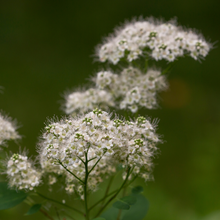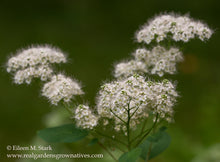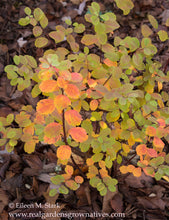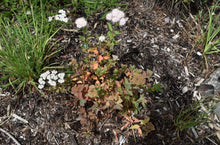
Spiraea betulifolia var. lucida
Birch-leaved spiraea's uniquely small stature, versatility and stunning fall color make it a must-have in most any Northwest native garden. In late spring, its stem tips are laden with flat clusters of tiny, white or blush pink flowers that are notoriously long-lasting and useful for pollinators. Flower clusters mature into golden brown seeds that are easy to overlook, but a delight to those that stop to appreciate all aspects of the growth cycle. Fall is this shrub’s prime time, when its toothed, egg-shaped leaves become aglow with an autumnal rainbow of color that will light up even your toughest garden locations.
- Plant type/canopy layer: deciduous, small shrub
- Size at maturity: 2-3' tall, equally wide
- Light requirements: full sun, part sun/part shade
- Moisture requirements: dry, moist to seasonably wet soil; prefers well drained
- Bloom time: May - Aug (July - August in the Portland Metro area)
- Growth rate/ease: medium growth rate, moderately easy to grow
- Wildlife support: flowers provide nectar for adult butterflies, bees, syrphid flies, moths and other insect pollinators; leaves and branches offer limited cover for birds and small mammals, but fallen leaves will protect the soil for overwintering invertebrates, which provide food for countless species; overall plant attracts and supports beneficial and pest eating insects and is a caterpillar host plant and larval food source
- Native habitat/range: uncommon, grows in meadows, edges of lakes, forest openings and edges, and on dry, rocky slopes and outcroppings from foothills to wetter forests at higher mountain elevations up to 1400m, from British Columbia to Oregon and eastward to Saskatchewan and Minnesota. Portland Plant List - yes.
- Special features & uses: medicinally a tea can be made from its branches, leaves or roots to treat abdominal and menstrual pains; landscape uses include pollinator gardens, rock gardens and edges of woodland gardens, erosion control and hedgerows; deer resistant; drought-resistant
Gardening with Birch-leaved Spiraea: Dense mounds of foliage stand less than 3ft, making this shrub one of the smallest in the native plant pallet and an excellent choice for borders and foundation plantings. Plus, it's highly versatile and drought-tolerant, capable of thriving in full sun to part shade and a wide range of soil types, but preferably well-drained. Removing faded flowers and providing infrequent/deep water during the summer drought will encourage additional blooms. It flowers on first year growth, so prune older stems in late winter or early spring if needed. Consider coupling it with other “pioneer” species like pearly everlasting and yarrow.
Photo Credit 1, 2, 3: Eileen Stark
Photo Credit 4: Tara Lemezis, Tiny Seed Photography
Photo Credit 5: Nikkie West, Sparrowhawk Native Plants







